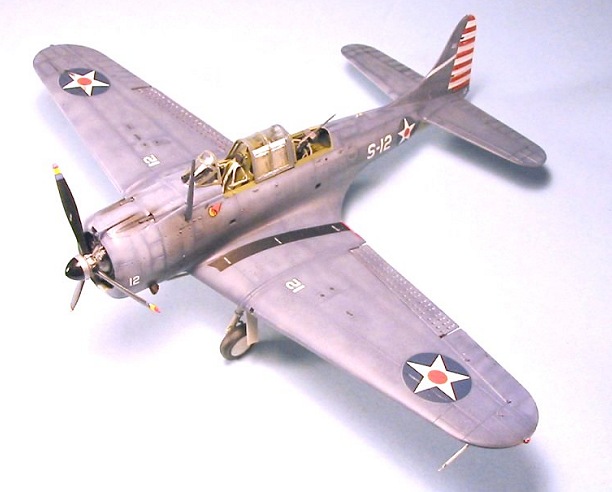
|
KIT: |
Accurate Miniatures 1/48 SBD-3 |
|
KIT # |
? |
|
PRICE: |
$34.95 |
|
DECALS: |
One option |
|
REVIEWER: |
Tom Cleaver |
|
NOTES: |

|
HISTORY |
The Battle of the Coral Sea, fought May 7-8, 1942, was historic in being the first naval battle in history in which ships of the opposing fleets never came within sight of each other, and in which aircraft carriers constituted the backbone of the respective battle fleets, and their aircraft the primary striking force. While it ended in a tactical defeat for the U.S. Navy with the large fleet carrier U.S.S. “Lexington” sunk and the U.S.S. “Yorktown” badly damaged against the loss of the light carrier IJN “Shoho” and the two fleet carriers “Zuikaku” and “Shokaku” damaged, the end result was a strategic victory for the Allies in the Southwest Pacific since the Japanese were prevented from invading Port Moresby in New Guinea, which might have led to the defeat of the U.S. and Australian armies there. Of even more importance, the damage suffered by the two veteran fleet carriers prevented their participation in the most important sea battle of the Pacific War the following month at Midway. Their absence gave the U.S. Navy just enough chance to stop the previously-victorious Japanese and turn the tide of war.
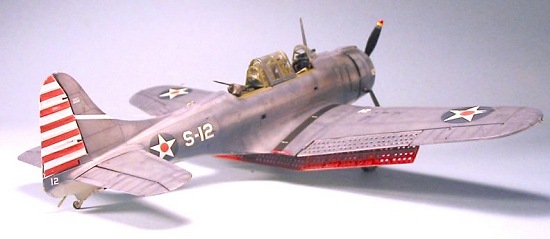 While
carrier-operating navies had theorized before the war about the role of
carriers and aircraft in a sea battle, they had always been seen - by
both the United States and Japanese navies - as supporting ships for the
main battle line, with the decisive engagement being fought between
battleships in the manner of the First World War Battle of Jutland. The
loss of the Pacific Fleet’s battle force at Pearl Harbor had forced the
U.S. Navy to revise their tactics through force majeure, but no
one yet knew exactly how to fight a carrier battle. The two days of
Coral Sea would enforce a steep learning curve on both forces.
While
carrier-operating navies had theorized before the war about the role of
carriers and aircraft in a sea battle, they had always been seen - by
both the United States and Japanese navies - as supporting ships for the
main battle line, with the decisive engagement being fought between
battleships in the manner of the First World War Battle of Jutland. The
loss of the Pacific Fleet’s battle force at Pearl Harbor had forced the
U.S. Navy to revise their tactics through force majeure, but no
one yet knew exactly how to fight a carrier battle. The two days of
Coral Sea would enforce a steep learning curve on both forces.
Naval intelligence had discovered the Japanese convoy that was to bring additional troops to New Guinea for the assault on Port Moresby, the main Allied base on the island. Taking Port Moresby would mean the Japanese would control New Guinea, thus cutting off Australia and New Zealand from U.S. trans-Pacific support. The convoy had to be stopped.
Task Force 17, comprised of the fleet carriers “Lexington” and “Yorktown” had been on extended operations in the Coral Sea south of the Solomon Islands since April 30th. Overall commander was VADM Frank Jack Fletcher, a non-aviator, with his flag in “Yorktown,” with RADM Aubrey W. Fitch, an experienced aviator, aboard “Lexington.” Both carriers were still operating their prewar air groups, VF-5, VS-5, VB-5 and VT-5 aboard “Yorktown,” with VF-2, VS-2, VB-2 and VT-2 aboard “Lexington.” The fighter squadrons operated 18 F4F-3 “Wildcats,” with the scouting and bombing squadrons quipped with the Douglas SBD-3 “Dauntless,” while the torpedo squadrons used the Douglas TBD-1 Devastator. They would be opposed by two veteran Japanese air groups - veterans of the Pearl Harbor raid and all pre-war trained, making them among the best naval aviators in the world - equipped with the superb Mitsubishi A6M2 “Zero-Sen”, the Aichi D3A-1 dive bomber that would soon be known to the allies as “Val,” and the Nakajima B5N-2 to be known as the “Kate.” Each of these aircraft outperformed their American counterpart, and were considered the best carrier-based combat aircraft in the world at the time.
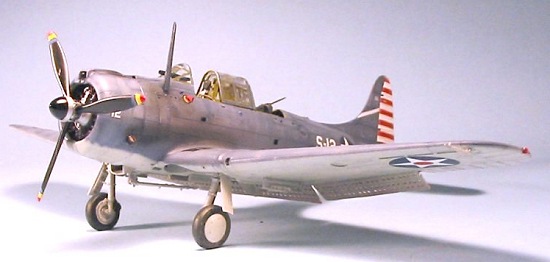 On May 2, the
Americans learned the Japanese had landed on Tulagi in the Solomons,
which could pose a threat to naval operations in the region. While “Lexington”
met her auxiliaries for an underway replenishment in the southern Coral
Sea, Fletcher took “Yorktown” for a high speed run north, launching a
strike against Tulagi on the morning of May 4; the Solomons were so
little-known at the time that the aviators had to make do with photos
from an old copy of National Geographic to know anything about the
target - there were no charts or maps available. Attacking over
Guadalcanal, Tulagi was found full of shipping, and the Dauntlesses went
in to the attack. In the attack, they discovered a problem of fighting
in the tropical Pacific: diving from high altitude into the warmer air at
lower altitude, the windscreens and sights fogged up. The 15 SBDs only
managed two hits, while VB-5s rear gunners shot down a Rufe, the
first of the type seen in combat. A second strike in the early afternoon
found the harbor empty. Japanese losses in both strikes were
inconsequential, though the Americans claimed a significant victory. “Yorktown”
then steamed south to meet “Lexington.”
On May 2, the
Americans learned the Japanese had landed on Tulagi in the Solomons,
which could pose a threat to naval operations in the region. While “Lexington”
met her auxiliaries for an underway replenishment in the southern Coral
Sea, Fletcher took “Yorktown” for a high speed run north, launching a
strike against Tulagi on the morning of May 4; the Solomons were so
little-known at the time that the aviators had to make do with photos
from an old copy of National Geographic to know anything about the
target - there were no charts or maps available. Attacking over
Guadalcanal, Tulagi was found full of shipping, and the Dauntlesses went
in to the attack. In the attack, they discovered a problem of fighting
in the tropical Pacific: diving from high altitude into the warmer air at
lower altitude, the windscreens and sights fogged up. The 15 SBDs only
managed two hits, while VB-5s rear gunners shot down a Rufe, the
first of the type seen in combat. A second strike in the early afternoon
found the harbor empty. Japanese losses in both strikes were
inconsequential, though the Americans claimed a significant victory. “Yorktown”
then steamed south to meet “Lexington.”
On May 6, B-17s from Port Moresby discovered the invasion force, and the fleet - now knowing the Japanese were in the region - prepared for battle the following day. Everyone was keyed up, knowing they would go up against the Japanese “first team.”
At dawn, both carriers steamed in rainstorms under a tropical front. At 0645 conditions improved enough to launch the search aircraft. At 0815, VS-5 found the Japanese main force, spotting “Shokaku” and “Zuikaku.” The Japanese had already spotted the Americans, but the report was off by 78 miles on the location. With the distance to the Japanese down to 175 miles, “Lexington” began launching her strike at 0925. The CAG, CDR William Ault, headed the formation of 50 Wildcats, Dauntlesses and Devastators. At 1005, “Yorktown” launched 43 aircraft. Mission assembly of a two-carrier force had never been done before, and it was 30 minutes later before all 93 aircraft were formed up and headed toward the target.
 Fate
intervened when a B-17 sent in a report of the invasion fleet, noting a
carrier. Fletcher and his staff were in a quandary. Everything they
knew said the strike had to be directed at the nearest enemy carrier in
order to protect their ships, and this position was closer than that of
the main force. What they didn’t know was that the light carrier “Shoho,”
the carrier that had been spotted, did not carry an air group big enough
to constitute a threat to the American fleet. The scouts returned, and
the pilot who had reported the two Japanese carriers corrected his report
to two cruisers, not carriers. The strike force was notified of the new
target, and diverted from their main target.
Fate
intervened when a B-17 sent in a report of the invasion fleet, noting a
carrier. Fletcher and his staff were in a quandary. Everything they
knew said the strike had to be directed at the nearest enemy carrier in
order to protect their ships, and this position was closer than that of
the main force. What they didn’t know was that the light carrier “Shoho,”
the carrier that had been spotted, did not carry an air group big enough
to constitute a threat to the American fleet. The scouts returned, and
the pilot who had reported the two Japanese carriers corrected his report
to two cruisers, not carriers. The strike force was notified of the new
target, and diverted from their main target.
In clear skies, the American strike force spotted the “Shoho” and the invasion fleet and set up their attack. At 1115, CDR Ault began the first American dive against a Japanese carrier of the Pacific War. The “Lexington” strike group included Lt.(j.g.) John Leppla, with gunner ARM3 John Liska, who were the fourth to dive behind Squadron CO LCDR Dixon, as two Zeroes flashed in to attack the dive bombers. Of 10 bombs dropped by VS-2, three hits were claimed, with 6 near misses. In their dive, Liska shot down both attacking Zeroes with his single .30-caliber machine gun. A third Zero overshot “Sail-12" to try an attack on the number three SBD. Leppla rolled off the attack for a moment and exploded the third Zero, then rolled back into his attack and scored a near miss. Leppla and Liska had shot down three Zeroes in 30 seconds in the midst of an attack dive.
The two American air groups overwhelmed “Shoho”, which sank 20 minutes after the first dive by Ault, sliding under the ocean at 20 knots. Exultant, VS-2 Commander Bob Dixon broke radio silence at 1136 to report, “Scratch one flattop! Dixon to carrier. Scratch one flattop!” It was the first time in history carrier-based aircraft had sunk an enemy aircraft carrier, and the first time since Pearl Harbor the Japanese had lost anything bigger than a destroyer. By sinking “Shoho,” the Americans achieved their strategic goal: deprived of carrier air cover, the invasion fleet had no choice but to turn back that night.
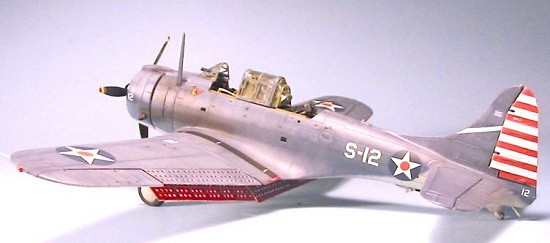 While the main
Japanese force completely missed Task Force 17 on May 7th,
finding the oiler “Neosho” and destroyer “Sims” at the
location given by their scout, sinking the “Sims” and leaving the
“Neosho” in sinking condition, the closest they came to their real
target was when several torpedo bombers mistook the “Yorktown” for
their home carrier in the twilight and attempted to land aboard before
being shot down by AA.
While the main
Japanese force completely missed Task Force 17 on May 7th,
finding the oiler “Neosho” and destroyer “Sims” at the
location given by their scout, sinking the “Sims” and leaving the
“Neosho” in sinking condition, the closest they came to their real
target was when several torpedo bombers mistook the “Yorktown” for
their home carrier in the twilight and attempted to land aboard before
being shot down by AA.
May 8 dawned with CAVU weather over the Americans, while the two Japanese carriers lay under the cover of a storm front. American scouts again found the Japanese, with Lt. (J.g.) C.V. Smith giving the report. Unfortunately, weather conditions were such he had to fly for 20 minutes to find conditions where his message could reach the fleet, and the transmission broke up without Fletcher being able to determine the distance to the target. Nevertheless, he ordered an attack. 122 American aircraft on two carriers were opposed by 121 Japanese. Fletcher knew the importance of getting off the first strike; “Lexington launched 43 aircraft and “Yorktown” 39 - only the Wildcats and several SBDs remained for defense against the expected Japanese strike.
As the Americans headed north toward the Japanese, they passed the incoming Japanese strike. Short battles happened as the fighters escorting each force attempted to attack the other.
In the bad weather that morning over the target, the American strike on the Japanese was uncoordinated, and resulted in only a few hits and minor damage to “Zuikaku,” while “Shokaku” was hit three times and set afire, damaged badly enough to be unable to recover her strike; the returning Americans reported her sunk.
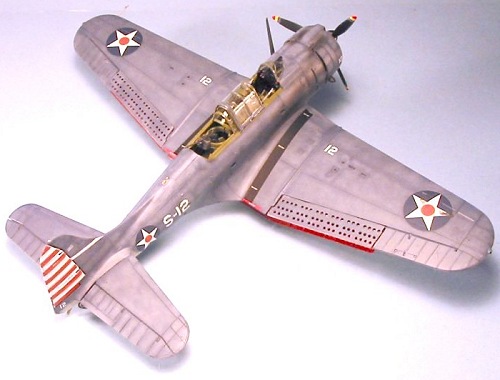 In the clear
air over Task Force 17, the Americans were about to discover how good the
Japanese were. 90 Japanese aircraft arrived over the carriers at 1118.
The Japanese torpedo bombers didn’t need to drop to wavetop height,
throttle back to 100 mph, and drop within 1,000 yards as did the TBDs.
The Kates swept in at over 180 knots, diving from 10,000 feet, and
dropping their high speed Long Lance torpedoes at 1,000 feet. The first
the American Combat Air Patrol knew where the enemy was when they saw the
drop - above them. While the Wildcats clawed for altitude to go after the
dive bombers that tipped over above them and dove on the two big targets
in the middle of the task force., the Dauntlesses strained to catch the
rapidly-escaping Kates.
In the clear
air over Task Force 17, the Americans were about to discover how good the
Japanese were. 90 Japanese aircraft arrived over the carriers at 1118.
The Japanese torpedo bombers didn’t need to drop to wavetop height,
throttle back to 100 mph, and drop within 1,000 yards as did the TBDs.
The Kates swept in at over 180 knots, diving from 10,000 feet, and
dropping their high speed Long Lance torpedoes at 1,000 feet. The first
the American Combat Air Patrol knew where the enemy was when they saw the
drop - above them. While the Wildcats clawed for altitude to go after the
dive bombers that tipped over above them and dove on the two big targets
in the middle of the task force., the Dauntlesses strained to catch the
rapidly-escaping Kates.
“Yorktown” managed to avoid the torpedoes launched at her, though she eventually took a bomb through the flight deck that seemed fatal until the fires were brought under control. In the meantime, “Lexington” took two torpedoes, but her damage control parties were effective and she was able to continue flight operations, though she listed to port.
Among the SBDs launched for anti-torpedo plane CAP was “Sail 12" with Leppla and Liska. Freed of the weight of a bomb, armed with two .50 calibers in the nose and a .30 caliber in back, as maneuverable as the Dauntless was, they would have had a good chance of stopping the Japanese cold, had the Kate performed like a Devastator. “Sail 12" became entangled with escorting Zeroes. Leppla splashed one right off, then a second. Heavily damaged by the attentions of a third, Leppla managed to escape and headed toward “Lexington” to get back aboard. Two more Zeroes came in on them; Liska exploded one and the other turned away. “Sail 12" managed to get back to “Lexington” where Leppla landed aboard.
At 1247, the first of three explosions wracked the “Lexington,” caused by gas vapors escaping a fractured fuel line. A second explosion at 1445 forced cancellation of further flight operations, after she had taken aboard about half of her air group. After the third explosion at 1630, she was dead in the water, and Captain Forrest Sherman ordered “abandon ship.” “Lexington,” the Navy’s third carrier, pioneer of naval aviation development for 14 crucial years, settled on an even keel at about 1930, taking 14 SBDs - including “Sail 12" - 13 TBDs and 9 F4Fs with her.
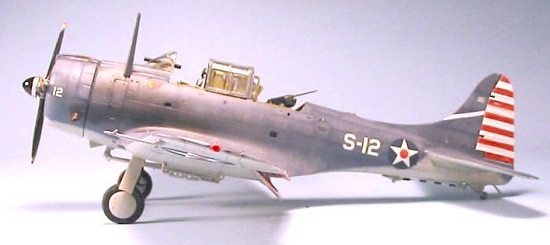 For the next
two days “Yorktown” ran for her life, south from the Coral Sea
with a full deckload of armed SBDs from both air groups, expecting
momentary attack; in the event an enemy force was spotted, the SBDs were
considered expendable so long as they got in enough hits to slow the
pursuing Japanese, because the carrier would be unable to take them back
aboard once launched. Fortunately, the Japanese had also withdrawn to
lick their wounds.
For the next
two days “Yorktown” ran for her life, south from the Coral Sea
with a full deckload of armed SBDs from both air groups, expecting
momentary attack; in the event an enemy force was spotted, the SBDs were
considered expendable so long as they got in enough hits to slow the
pursuing Japanese, because the carrier would be unable to take them back
aboard once launched. Fortunately, the Japanese had also withdrawn to
lick their wounds.
“Yorktown” arrived at Pearl Harbor with the survivors of “Lexington” - including Leppla and Liska - on May 26, entering drydock on May 27 for 72 hours of non-stop repairs to enable her to sortie on May 31, headed for the coming Battle of Midway, which she would not survive; had she not been there, it is unlikely that “Enterprise” and “Hornet” could have struck the Japanese fleet as heavily as they did, since it was SBDs from “Yorktown” that sank “Soryu.”
John Leppla had proven himself a fighter pilot and was promoted to Lieutenant, then assigned to VF-10, which went aboard “Enterprise” a month before the Battle of Santa Cruz. He was killed in combat as an escort pilot in the strike against the Japanese carriers on October 26, 1942.
|
THE KIT |
Many modelers will argue over whether it is the Accurate Miniatures SBD Dauntless or TBF Avenger that makes up into the best, most‑accurate, most‑detailed plastic kit ever as an OOB project. Myself, I come down on the side of the SBD, but for the personal reason of liking the Dauntless better ‑ not for any intrinsically‑better quality of the model. It's really a choice of six of one, half a dozen of the other kit‑wise. Of course, the good news in the last 18 months has been the resurrection of Accurate Miniatures under new ownership and management, which has resulted in the re-release of their kits, with the SBD-3 Dauntless among them.
|
CONSTRUCTION |
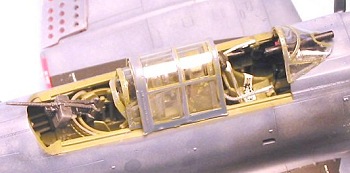 The original
Accurate Miniatures SBD‑3 kit was of the early SBD‑3 that had the single
gun rear turret. The decals provided in the kit are for the airplane
flown by Leppla and Liska at the Battle of Coral Sea. Thus, this was a
straight “out of the box” project.
The original
Accurate Miniatures SBD‑3 kit was of the early SBD‑3 that had the single
gun rear turret. The decals provided in the kit are for the airplane
flown by Leppla and Liska at the Battle of Coral Sea. Thus, this was a
straight “out of the box” project.
As regards construction, I found over the many Dauntless kits I have built that one merely needs to follow the instructions, use the color photos in the Detail & Scale Dauntless book for painting instructions in the cockpit, and be careful with the fiddly bits of the instrument panel, rudder pedals and foot guides in order to come up with a beautiful model. Oh, all that and I also discovered that if you assemble the lower wing to the fuselage, then attach the upper wings, you will have no need of using any putty other than some Mr. Surfacer for the centerline seam on the fuselage.
If you are going to "stack" the canopy in the open position, it's a good idea to sand down each of the interior parts of the stack, so everything looks just right in the end; test‑fitting all this will show you exactly what you have to do.
|
COLORS AND MARKINGS |
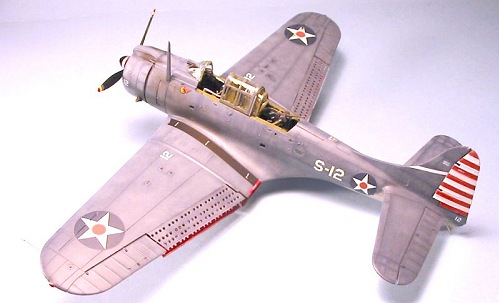 I painted the
model with Gunze Sanyo H‑43 "Blue Grey," a gloss color, and H‑51 Light
Gull Grey. I did apply pre‑shading to the model, and also applied some
post-shading by lightening the upper surface color with some of the Gull
Grey to simulate the sun fading that would have happened to these
airplanes during their tour aboard the “Lexington” in the months
prior to the Battle of the Coral Sea.
I painted the
model with Gunze Sanyo H‑43 "Blue Grey," a gloss color, and H‑51 Light
Gull Grey. I did apply pre‑shading to the model, and also applied some
post-shading by lightening the upper surface color with some of the Gull
Grey to simulate the sun fading that would have happened to these
airplanes during their tour aboard the “Lexington” in the months
prior to the Battle of the Coral Sea.
As to decals, I used the kit sheet for everything. As the instructions point out, the well-known markings for this airplane in the full “2-S-12" designation was really an airplane at the Douglas plant in El Segundo that Leppla and Liska sat in and on for publicity photos after the battle. The actual airplane that flew in combat had the designator changed to a simple “S-12". It is not known whether the squadron insignia for VS-2 was carried during the battle, so I decided to use the decal because it adds to the colorful look of the model. The decals go down without problem under a coat of Micro-Sol.
|
FINAL CONSTRUCTION |
After the model had been Futured, I then covered it with two coats of thinned Dullcote, then applied the exhaust stains with Tamiya"Smoke." When all was dry, I attached the dive brakes and landing gear, “stacked” the cockpit, and attached the rear machine gun to the turret. I decided not to attach a bomb, since Leppla and Liska did not achieve fame in this airplane in its dive-bombing role, but rather in an improvised “fighter” role.
|
CONCLUSIONS |
What can I say that hasn’t been said before? It’s the Accurate Miniatures Dauntless, and it’s a superb kit. You can’t build a model with more detail in 1/48 scale “out of the box,” and the kit is as definitive in accuracy and quality as can be. No self-respecting collection of naval aircraft of the Second World War should be without several of these models of World War II’s most important dive bomber.
March 2004
Thanks to Accurate Miniatures for the review kit.
If you would like your product reviewed fairly and quickly by a site that has nearly 250,000 visitors a month, please contact me or see other details in the Note to Contributors.